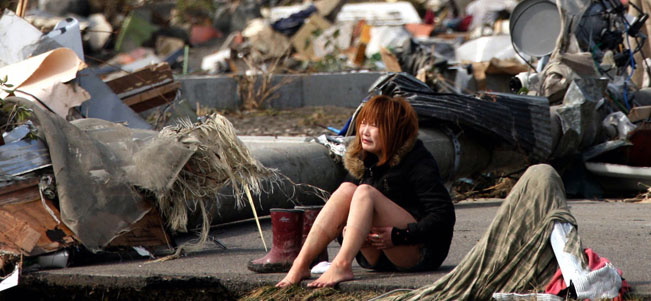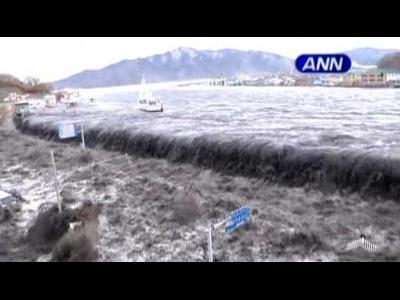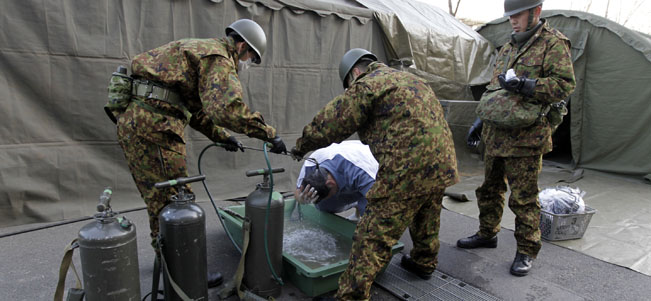TOKYO (Reuters) – The Daiichi nuclear power plant in Fukushima is built right on the shoreline in northeast Japan. So when an 8.9 magnitude earth quake struck on Friday, the tsunami waves it spawned -- tall as a house and speeding like a jet plane -- crashed over the reactors and put them at risk of a meltdown.
Another hydrogen explosion rocked the plant on Monday while engineers were flooding the three reactors in the complex with sea water in a desperate attempt to prevent what was shaping up as the worst nuclear emergency since the Chernobyl disaster 25 years ago.
U.S. warships and planes helping the relief efforts have moved away from the coast temporarily because of low-level radiation from the stricken nuclear power plant, the U.S. Navy said on Monday. Singapore said it was checking Japanese food imports for radioactive contamination.
The nuclear crisis was a triple whammy for Japan, coming on top of the earthquake -- the fifth strongest ever recorded -- and one of the most powerful tsunami in history, which caused scenes of unimaginable destruction in northeast Japan.
Japan's Prime Minister Naoto Kan said the country was facing its biggest crisis since the end of the Second World War, which was when the United States dropped atomic bombs on Hiroshima and Nagasaki.
"We're under scrutiny on whether we, the Japanese people, can overcome this crisis," Kan told a Sunday night news conference, his voice rising with emotion.
The quake caused Japan's main island to shift 2.5 meters (8 feet) and moved the earth's axis 10 cm (2.5 inches), geologists say. The question now is whether the catastrophe will spur other seismic changes in Japan, which has yet to emerge from its "lost decades" of stagnant growth, aging population, and loss of international prestige following the collapse of the Japanese asset bubble in the early 1990s.
At the very least, the drama at Fukushima is bound to shake the faith of many Japanese in the safety of their nuclear plants. The catastrophe will also sorely test Kan's deeply unpopular government. And the immense reconstruction effort that is coming may bring changes to rural Japan, where many of its older citizens live.
Kan flew over the stricken nuclear plant and quake-hit areas on Saturday morning after ordering an evacuation in the area. He borrowed a military camouflage jacket with the name tag "Miyamoto" for a brief visit to the stricken nuclear plants.
"I came to realize the huge magnitude of damage the tsunami has wrought," he told reporters on his return to Tokyo, this time wearing the blue uniform of the disaster response teams.
Just before the quake hit on Friday, he was sitting slumped in his seat parliament listening to opposition demands for his resignation over yet another Japanese political funding scandal.
But on Sunday night he was urging the public not to be pessimistic because Japan will enjoy "a New Deal-like" economic recovery on the back of the massive reconstruction task ahead.
That must have sounded like cold comfort to millions left homeless and bereft in Japan's late winter countryside.
SHIP IN NEIGHBOURHOOD
If any country is prepared to cope with an earthquake, it is Japan.
Earthquakes are a way of life in Japan, occurring on average every five minutes. By law, buildings are erected to withstand violent tremors. As office towers shook violently in Tokyo on Friday, people grabbed helmets and dove under their desks, hoping their quake-resistant buildings could withstand the damage. School children are drilled on what to do when a quake hits. Many households have survival kits.
This quake, however, was on a completely different scale, and left the country of 127 million people dazed and bewildered.
The tsunami, a Japanese word meaning "harbor wave," surged through towns and cities, bulldozing everything in its path. A large freight ship was sitting incongruously in the streets of Kesennuma in hard-hit Miyagi prefecture. A wrecked airplane lay nose-deep in the rubble of homes in the port of Sendai.
"Is it a dream? I just feel like I'm in a movie or something," said Ichiro Sakamoto, 50, in Hitachi city, around 129 kms (80 miles) north of Tokyo, where fishing boats were tossed far inland by the series of three tsunami waves.
A multistorey building stood alone in a vast wasteland after the tsunami waves roared through the small coastal town of Rikuzentakata. Cars were piled atop one another, train carriages tossed carelessly aside.
At least 10,000 people are feared killed by the earthquake. But the number of missing is still in the tens of thousands and the death toll could soar.
A humanitarian relief operation of epic proportions was under way. The government was preparing to double to 100,000 the number of Self Defense forces being mobilized along with police, the Coast Guard, and disaster response teams.
The United States has sent nine warships with humanitarian aid, led by the aircraft carrier USS Ronald Reagan, underlining the close military ties with its Pacific ally.
Millions are spending the cold nights without water, electricity, homes or heat.
Survivors huddled under blankets in Rikuzentakata. Others stood in front of posters with a list of the dead and missing, some weeping. Many of them were middle aged or elderly, reflecting Japan's rapidly aging population.
Kazuaki Sakai, 70, said he watched from a hill as the tsunami waves roared into the town.
"First the sea pulled back so much that I could almost see the bottom. About 10 minutes after the quake the first (wave) hit and pulled back, and then the next wave hit about 10 meters high, completely black, making a whirlpool. Then that one pulled back and I could see the (sea) bottom again. That repeated for about 10 times in about a half-hour."
Michiko Yamada, 75, said she ran to the rooftop of a hospital and stayed there for 12 hours with her husband in complete darkness. "I ran away with what I'm wearing, barefoot. It was truly cold," she said at a middle school shelter in Rikuzentakata. "I don't have anything now. No money, no house. "I'm on way now to borrow socks from my relatives."
Many of the survivors appeared middle aged or elderly, reflecting Japan's aging demographic, particularly in rural areas where the average age of farmers is about 66.
The tsunami swept over a vast area of rural Japan, destroying an untold amount of rice paddy farmland.
This could accelerate changes affecting Japan's politically powerful farmers, whose average age is 66. They are protected by import tariffs in excess of 700 percent for polished rice. The government has been pushing to reform a sector that makes up just 1 percent of the economy by giving them greater scope to lease land to companies.
ECONOMIC IMPACT
Any dividend from reconstruction and reform looked distant on Monday. Japanese stocks fell 7.6 percent, on track for the biggest daily loss since October 2008, and bond yields rose as investors expected the disaster to take a huge economic toll and require heavy government borrowing.
At least six Japanese seaports handling international trade have sustained major damage, with most likely to be out of operations for months, said an industry official on Monday. That could pose challenges for global supply chains.
The Bank of Japan pumped record funds into the banking system to shore up confidence on Monday. But the central bank said it was sticking to its view that the world's third largest economy would resume its moderate recovery, though output would fall in at least for the short term.
"Output is likely to fall for some time. We are also worried that corporate and household sentiment will worsen," the BOJ said in a statement after its board voted to double the 5 trillion fund pool put in place last October to support Japan's recovery after the global economic crisis.
The central bank said it was ready to throw 15 trillion yen ($183 billion) into the banking system to ensure markets function properly.
Most analysts agreed with Kan that Japan will eventually enjoy a boost from reconstruction, after suffering a temporary economic hit, with household consumption rising to replace damaged homes and goods.
"It is sufficiently possible to expect demand that should be called a restoration New Deal," Kan told his economic ministers.
But the cost of rebuilding will also worsen Japan's already worryingly high public debt burden, the largest among advanced economies and double the size of its $5 trillion gross domestic product.
Some economists said the scale of the disaster and its consequences remained far from clear, especially with the nuclear plants at risk.
"Not since the Cold War have I been asked to think about the economic consequences of a nuclear explosion in a densely populated area in a modern industrial economy," said Carl Weinberg, chief economist at High Frequency Economics in New York. "I don't relish that task."
As for the world economy, Japan is not a major engine of global growth so the disaster poses less of a risk to other countries than soaring oil prices caused by turmoil in the Middle East and North Africa.
"The global economy will be fine," said Stephen Stanley, chief economist at Pierpont Securities in Stamford, Connecticut.
Hopes surfaced the disaster could end the debilitating political warfare that has prevented the government from crafting policies to cope with a bulging debt and fast-aging society.
But pessimists said chances were slim that rivals to the unpopular prime minister inside and outside his own party would keep off the gloves for long. Opposition parties are pressing the premier to call a snap election they think they could win, while critics in the ruling party want him to resign to improve their own chances.
Kan is already Japan's fifth leader since 2006.
"Kan's government avoided a crisis due to this huge disaster," said independent political analyst Minoru Morita. "As long as media are reporting only about the disaster, Kan's government will be stable," he said. "Once the news returns to normal, criticism will emerge again."
THE TEPCO SYNDROME
Kan has his hands full dealing with the nuclear emergency.
A hydrogen explosion on Monday at the number 3 reactor raised concern the crisis is escalating, but experts insist a Chernobyl-style nuclear disaster can be averted.
Three units at the Fukushima Daiichi plant suffered loss of coolant to their reactors after the quake triggered automatic shutdown systems, and then the tsunami knocked out the backup generators.
So long as the thick containment walls shielding the reactor cores remain intact, even a meltdown of the nuclear fuel would not lead to a major escape of potentially dangerous radioactive clouds into the air.
"Everything I've seen says that the containment structure is operating as it's designed to operate. It's keeping the radiation in and it's holding everything in, which is the good news," said Murray Jennex, of San Diego State University.
"This is nothing like a Chernobyl... At Chernobyl (in the Ukraine in 1986) you had no containment structure -- when it blew, it blew everything straight out into the atmosphere."
The incident is the latest mishap in Japan's nuclear industry.
The 40-year-old reactor facing a possible meltdown in Fukushima was originally scheduled to go out of commission in February but had its operating license extended another 10 years.
But the Japanese government's Nuclear and Industrial Safety Agency approved Tokyo Electric's application to keep it hot after inspecting the facility, according to a statement on the Ministry of Trade Economy Industry's website (www.meti.go.jp/english/index).
The company has had a rocky past in an industry plagued by scandal. In 2002, the president of the country's largest power utility was forced to resign along with four other senior executives, taking responsibility for suspected falsification of nuclear plant safety records.
A few years later, it ran into trouble again over accusations of falsifying data.
The fallout from the Fukishima nuclear plant accident could well give fresh momentum to opponents of nuclear energy. The industry in the United States, for instance, has never really recovered from the Three Mile Island mishap in 1979.
Japan is one of the giants of the world nuclear industry, producing almost 30 percent of its electricity from the source. Ambitions to boost this to 50 percent by 2030 may now be called into question.
"The public demands nothing less than perfection from the nuclear industry in terms of safety," Reuters columnist Christopher Swann wrote. "That's particularly true in Japan, the only nation to have endured a nuclear attack. Fear of radiation is deep-seated in the country -- just look at its great cinematic export, Godzilla movies. So a minor lapse could prove a big setback -- one that makes meeting the world's voracious demand for energy look still more intimidating."
 Play Video Earthquakes Video:Raw Video: New images of aftermath in Japan AP
Play Video Earthquakes Video:Raw Video: New images of aftermath in Japan AP  Play Video Earthquakes Video:Scale of Japan quake-tsunami destruction revealed AFP
Play Video Earthquakes Video:Scale of Japan quake-tsunami destruction revealed AFP  Play Video Earthquakes Video:Tokyo stocks hammered, BoJ unleashes record funds AFP
Play Video Earthquakes Video:Tokyo stocks hammered, BoJ unleashes record funds AFP (Additional reporting by Ran Kim, Yoko Kuboto, Chris Meyers, Chisa Fujioka, Tim Kelly, Taiga Uranaka, Ki Joon Kwon, Elaine Lies, Risa Maeda and Leika Kihara; writing by Bill Tarrant)
http://news.yahoo.com/s/nm/20110314/wl_nm/us_japan_quake_specialreport;_ylt=AilrI1h1xKMqi0vVscTv1vBvaA8F;_ylu=X3oDMTJ0YmZlbTJjBGFzc2V0A25tLzIwMTEwMzE0L3VzX2phcGFuX3F1YWtlX3NwZWNpYWxyZXBvcnQEY3BvcwMyBHBvcwM1BHNlYwN5bl90b3Bfc3RvcnkEc2xrA3NwZWNpYWxyZXBvcg--


















